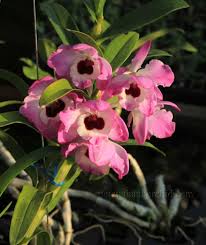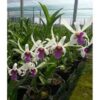# Methods for Growing Dendrobium Orchids in Water

Dendrobium orchids, belonging to one of the largest genera in the Orchidaceae family, are prized for their striking beauty, diverse forms, and relatively easy care. While many orchid enthusiasts grow these plants in pots with various growing media, cultivating Dendrobium orchids in water is becoming increasingly popular. This method, known as hydroponic orchid growing, allows for a controlled environment where plants can thrive without traditional soil. In this article, we will explore the various methods for growing Dendrobium orchids in water, covering everything from the basics of hydroponics to specific techniques, care requirements, and troubleshooting tips.
## Understanding Dendrobium Orchids
### The Dendrobium Genus
Dendrobium is a diverse genus that includes over 1,800 species, many of which are popular among orchid enthusiasts. These orchids are native to tropical and subtropical regions, making them well-suited for warm environments. They exhibit a wide range of growth habits, with some species growing as epiphytes (on trees), lithophytes (on rocks), or terrestrial plants (in the ground).
### Characteristics of Dendrobium Orchids
– **Pseudobulbs**: Many Dendrobium species develop pseudobulbs that store water and nutrients, enabling them to survive in varying conditions.
– **Flowering**: Dendrobium orchids are known for their vibrant and diverse flowers, which can bloom in various colors and shapes.
– **Light and Humidity Needs**: These orchids thrive in bright, indirect light and require a humid environment to flourish.
## The Basics of Growing Dendrobium Orchids in Water
### What is Hydroponics?
Hydroponics is a method of growing plants without soil, using nutrient-rich water solutions to provide essential nutrients directly to the plant roots. This technique allows for better control over water, nutrients, and environmental conditions, leading to healthier and more vigorous plant growth.
### Advantages of Growing Dendrobium Orchids in Water
1. **Reduced Risk of Pests and Diseases**: Growing orchids in water can minimize the risk of soil-borne pests and diseases, providing a cleaner growing environment.
2. **Easier Nutrient Management**: Hydroponic systems allow for precise control over nutrient levels, ensuring that plants receive the essential elements they need for growth.
3. **Improved Aeration**: Water-based growing systems can provide better aeration to the roots, which is crucial for preventing root rot and promoting healthy growth.
4. **Space Efficiency**: Hydroponic setups can be more space-efficient than traditional growing methods, allowing for vertical gardening and increased plant density.
### Basic Requirements for Hydroponic Growing
1. **Containers**: Use clear plastic containers or glass vases to allow light penetration and monitor root health. Ensure the container is large enough to accommodate the roots.
2. **Water Quality**: Use distilled or filtered water to avoid chlorine and other chemicals commonly found in tap water. Check the pH level, aiming for a range between 5.5 and 6.5.
3. **Nutrient Solutions**: Utilize a balanced, water-soluble fertilizer specifically formulated for orchids. Follow the manufacturer’s instructions for dilution rates.
4. **Light**: Provide bright, indirect light, mimicking the natural habitat of Dendrobium orchids. Avoid direct sunlight, as it can lead to leaf burn.
5. **Humidity**: Maintain humidity levels between 50-70%. Use a humidity tray or mist the surrounding area to create a suitable environment.
## Methods for Growing Dendrobium Orchids in Water
### 1. Water Culture Method
The water culture method involves growing Dendrobium orchids directly in water without any medium. This straightforward approach is ideal for beginners and can yield impressive results.
#### Steps:
1. **Choose a Healthy Plant**: Select a healthy Dendrobium orchid with well-established roots. Avoid plants with signs of rot or damage.
2. **Prepare the Container**: Choose a clear container that allows for light penetration. Ensure it is clean and free of any contaminants.
3. **Root Preparation**: Rinse the roots gently in lukewarm water to remove any old media. Trim away any dead or damaged roots using sterilized scissors.
4. **Fill the Container**: Place the orchid in the container, ensuring the roots are submerged in water but the pseudobulbs and leaves are above the waterline.
5. **Add Nutrient Solution**: Dilute a balanced orchid fertilizer in the water, following the recommended dosage. Stir gently to mix.
6. **Maintain Water Levels**: Monitor the water level regularly and top up as needed. Change the water every two weeks to prevent stagnation and build-up of salts.
7. **Provide Light and Humidity**: Place the container in a bright location with indirect sunlight. Maintain humidity levels by using a humidity tray or misting.
### 2. Semi-Hydroponic Method
The semi-hydroponic method combines traditional potting with a water culture approach. This method allows for a controlled water supply while providing support for the plant.
#### Steps:
1. **Select a Container**: Use a clear plastic pot with drainage holes or a net pot to facilitate water flow and aeration.
2. **Prepare Growing Medium**: Fill the bottom of the pot with a layer of hydroton (expanded clay pebbles) or perlite to create a drainage layer. This will prevent waterlogging.
3. **Pot the Orchid**: Carefully place the Dendrobium orchid in the pot, ensuring the roots are spread out. Add more hydroton or perlite around the roots for support.
4. **Watering**: Water the pot thoroughly, allowing excess water to drain out. Ensure the medium remains moist but not waterlogged.
5. **Nutrient Solution**: Mix a diluted orchid fertilizer with the water used for watering. Regularly check the nutrient levels and adjust as needed.
6. **Light and Humidity**: Provide bright, indirect light and maintain humidity levels between 50-70%.
### 3. Wick System
The wick system is an innovative method that uses a wick to draw water from a reservoir into the growing medium. This technique ensures consistent moisture levels for the orchid.
#### Steps:
1. **Choose a Container**: Select a container with a reservoir for water and a pot for the orchid with drainage holes.
2. **Prepare the Wick**: Use a cotton or nylon wick, ensuring it is long enough to reach the water reservoir. Thread one end through the drainage hole in the orchid pot.
3. **Pot the Orchid**: Place the Dendrobium orchid in the pot with a suitable growing medium, such as hydroton or perlite.
4. **Set Up the Reservoir**: Fill the reservoir with distilled water and place the pot on top, ensuring the wick is submerged in the water.
5. **Monitor Water Levels**: Check the water levels in the reservoir regularly and refill as needed. The wick will draw water into the pot, keeping the medium consistently moist.
6. **Nutrient Management**: Add a diluted orchid fertilizer to the reservoir every few weeks to provide essential nutrients.
7. **Light and Humidity**: Ensure the orchid receives bright, indirect light and maintain adequate humidity levels.
### 4. Nutrient Film Technique (NFT)
The nutrient film technique is a more advanced hydroponic method that involves a thin film of nutrient-rich water flowing over the roots of the plant. This system requires careful setup but can produce excellent results.
#### Steps:
1. **System Setup**: Create a sloped growing channel that allows water to flow continuously over the roots. Use PVC pipes or a custom-made channel.
2. **Pump and Reservoir**: Set up a water pump to circulate the nutrient solution from a reservoir to the growing channel.
3. **Potting the Orchid**: Place the Dendrobium orchid in a net pot filled with a lightweight growing medium. Ensure the roots are exposed to the flowing nutrient solution.
4. **Nutrient Solution Preparation**: Mix a balanced orchid fertilizer with water and fill the reservoir. Set the pH level between 5.5 and 6.5.
5. **Monitor and Adjust**: Regularly check the flow of the nutrient solution and ensure the roots remain moist but not submerged. Adjust the nutrient levels as needed.
6. **Light and Humidity**: Provide bright, indirect light and maintain humidity levels suitable for Dendrobium orchids.
## Care Tips for Dendrobium Orchids Grown in Water
### 1. Water Quality
– Use distilled or filtered water to avoid chlorine and other chemicals that can harm the roots. Test the water’s pH and adjust as necessary.
### 2. Nutrient Management
– Use a balanced orchid fertilizer designed for hydroponic systems. Follow the manufacturer’s instructions for dilution rates and frequency of application.
### 3. Light Requirements
– Provide bright, indirect light, ideally from a south or east-facing window. Supplement with grow lights if natural light is insufficient.
### 4. Humidity Levels
– Maintain humidity levels between 50-70%. Use a humidity tray, mist the surrounding area, or place a humidifier nearby to achieve the desired moisture.
### 5. Temperature Control
– Dendrobium orchids thrive in temperatures between 65°F and 80°F (18°C to 27°C) during the day. Protect them from extreme temperature fluctuations.
### 6. Pruning and Maintenance
– Regularly check for dead or damaged roots and leaves. Trim away any unhealthy parts to promote healthy growth.
## Troubleshooting Common Issues
### 1. Root Rot
**Symptoms**: Dark, mushy roots; foul odor.
**Solution**: Remove the orchid from the water and inspect the roots. Trim away any rotten roots and repot in fresh,
clean water or medium.
### 2. Yellowing Leaves
**Symptoms**: Leaves turning yellow and dropping.
**Solution**: Assess light levels, watering frequency, and nutrient supply. Ensure the orchid is receiving adequate light and nutrients without waterlogging.
### 3. Poor Flowering
**Symptoms**: Lack of blooms or small flowers.
**Solution**: Ensure proper light, humidity, and nutrient levels. Consider adjusting the light cycle to promote flowering.
### 4. Algae Growth
**Symptoms**: Green slime or algae in the container.
**Solution**: Clean the container thoroughly, replace the water, and reduce light exposure to minimize algae growth.
## Conclusion
Growing Dendrobium orchids in water presents a unique and rewarding approach to orchid cultivation. With various hydroponic methods available, enthusiasts can choose the one that best fits their preferences and growing conditions. By understanding the specific needs of Dendrobium orchids and implementing proper care techniques, growers can enjoy healthy plants with stunning blooms. As you embark on your journey of growing Dendrobium orchids in water, remember that patience and observation are key to success. Happy growing!

